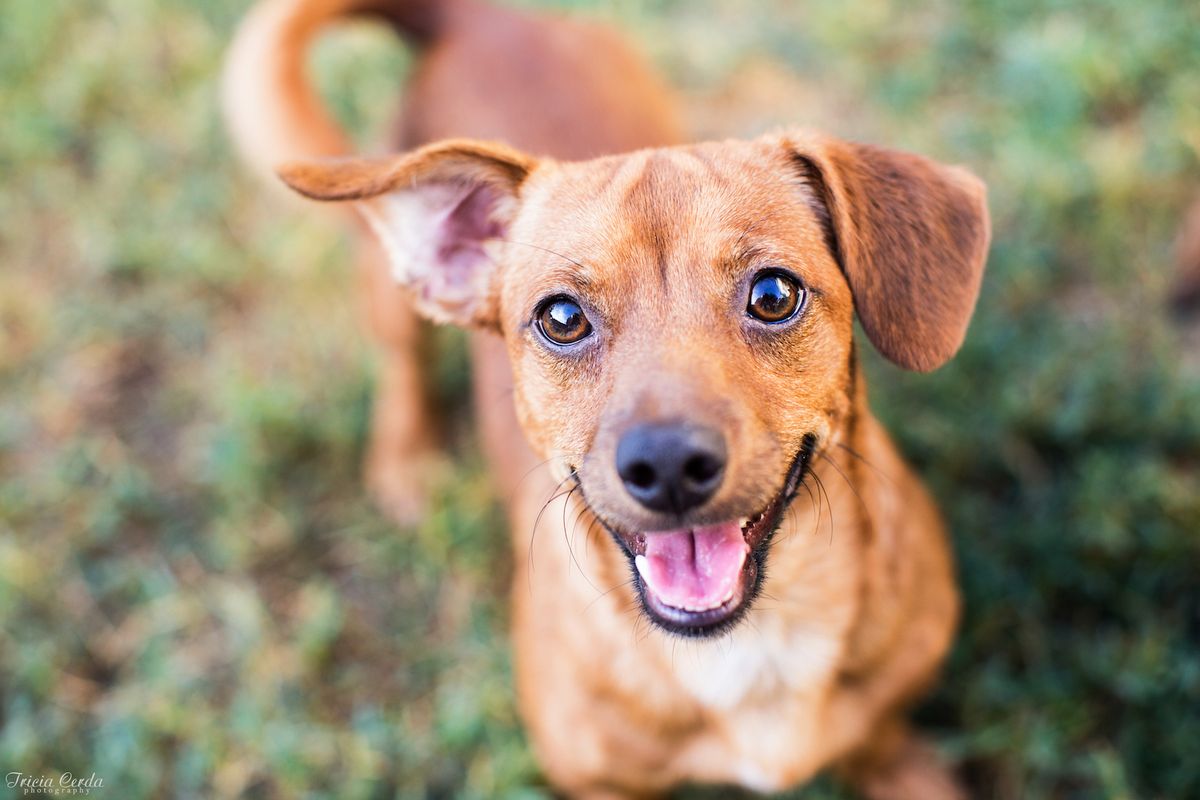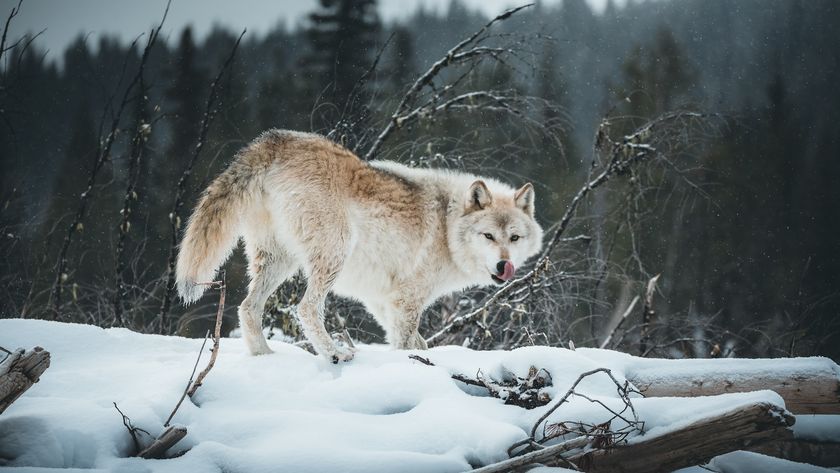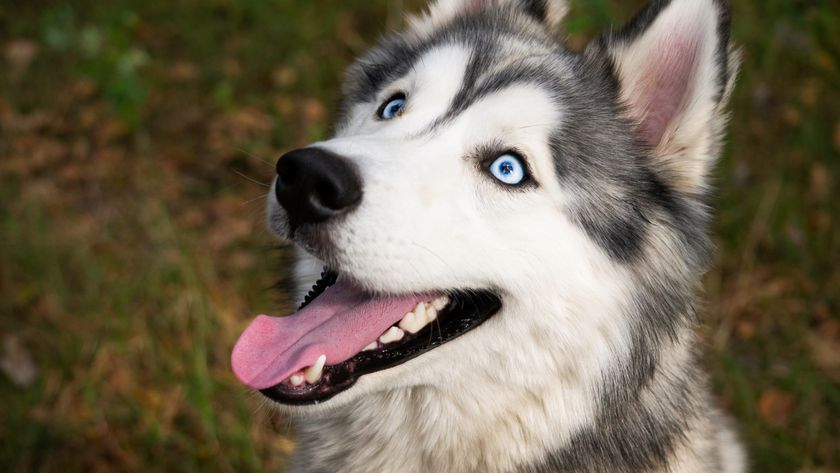
Are Dogs Really Smiling at Us?

The dog's mouth opens wide, her lips pull up at the corners, and her tongue lolls out. Most would look at this face and see an unmistakable grin. But is that really what's going on here? Do dogs use this expression in the same way as people, to convey their joy, pleasure or contentedness?
In other words, are dogs really smiling at us?
The answer has roots in our 30,000-year history of keeping dogs as domesticated animals. Thanks to that history, humans and dogs have developed a unique bond, which has also made dogs very useful subjects for the study of communication. "Studying dogs is a really unique opportunity to look at social communication between species," said Alex Benjamin, an associate lecturer in psychology, who studies dog cognition at the University of York in the United Kingdom. [20 Weird Dog and Cat Behaviors Explained by Science]
Most of this research also reinforces the idea that the communicative bond we share with dogs is unique. For instance, researchers have found that dogs embrace the human gaze and use eye contact in a way that few other animals do.
A study published in the journal Current Biology tested how wolves and dogs would respond to the impossible task of opening a container to get at some meat they knew was within. The researchers found that while the wolves would simply stalk off when they discovered they couldn't open it, dogs would turn around and give humans a long, inquiring gaze — suggesting that these animals knew a person could help them complete the task.
Another study, published in the journal Science, found that both dogs and humans experience an increase in levels of oxytocin — a hormone that plays a role in social bonding — when they lock eyes with one another. Even more intriguing, dogs that sniffed oxytocin would then spend more time staring at humans.
"[A shared gaze] is the fundamental mechanism for cooperation if you think about it," especially if, like dogs, you can't rely on spoken language, Benjamin told Live Science. Humans may have bred this trait into dogs over the course of their domestication, she said. "Dogs that look at us are much easier to cooperate with and train. So, it is possible that some unconscious or conscious selection may also have led to the behaviors we see today."
Sign up for the Live Science daily newsletter now
Get the world’s most fascinating discoveries delivered straight to your inbox.
In any case, it's clear that eye contact is important to dogs as a way to intentionally gather information and communicate.
But what about the expressions that cross their faces? Do these have any relevance to humans — and do dogs use them to communicate with us?
That question is intriguing, said Juliane Kaminski, a reader in comparative psychology at the University of Portsmouth in the United Kingdom, who studies dog cognition. She said she's especially interested in one particularly adorable expression in dogs: the inward raising of the brows that produces what's known as "puppy dog eyes."
For her research, Kaminski and colleagues visited a dog shelter, where they used something called a facial action coding system (FACS) to measure the minute facial motions dogs made while they interacted with people. Afterward, the researchers kept track of the time it took for each dog to get adopted. The scientists discovered that "the more the dogs produced that movement [puppy dog eyes], the quicker they were rehomed," said Kaminski. No other behavior the researchers analyzed had as strong an effect. [Is a Dog's Mouth Cleaner Than a Human's?]
Next, Kaminski wanted to find out if this behavior was intentional. "Have [dogs] either understood or learned that if they produce that movement, humans will do something for them?" Kaminski said. So, she set up another experiment, in which dogs were exposed to humans who either did or didn't offer food. If dogs knew the power of their sorrowful gaze, it would follow that those presented with the possibility of a snack would use it more often to get what they desired.
But … they didn't. While dogs were more expressive when they looked at humans — reinforcing the idea that eye contact is important for canine communication — the animals used their soppy-eyed expression just as much whether or not there was food involved. It's possible that humans unconsciously selected for this adorable trait as we domesticated canines, because "it resembles a movement that we produce when we are sad. So it kind of triggers this nurturing response," Kaminski said. "But that doesn't necessarily mean dogs have learned to exploit that."
That brings us to the "smile." Does your dog's wide-mouthed expression carry the same significance as a human grin? Kaminski advised caution. "I've had a dog all my life, so I know that if you know your dog really well, you're able to read its behaviors. I've got no problem with giving certain behaviors a label," she said. "But as a scientist, of course, I say, 'How would we know that?' We have zero data telling us what this actually means."
The problem with dog expressions is that our research tools are typically subjective, and paired with our anthropomorphizing tendencies, it's very possible that we misinterpret what we see on dogs' faces.
In fact, there's very little objective research to support the idea that dogs "smile." Some findings, published in the journal Scientific Reports, show that this particular expression, called "relaxed open mouth" in dogs, typically occurs in positive settings, like when dogs are inviting one another to play. But whether it's really what we would call a smile, or whether dogs are directing it at us intentionally to communicate something, remains unknown.
To answer that question, we'd need more-objective research techniques — such as FACS like Kaminski used — to determine how specific facial expressions correlate with particular situations and what precisely motivates those expressions. That's needed for all dog expressions, which are generally understudied, Kaminski said. [Why Do Dogs Wag Their Tails?]
This revelation is probably unsettling for any dog owner who has interpreted that upturned, open mouth as a smile all these years. But in some ways, it doesn't matter, because there is so much other proof of our special relationship with dogs.
Consider that they're the only creatures we know of that can successfully follow and understand human gestures, like pointing. Even chimps, our closest relatives, can't follow this communicative cue as well as dogs can. Also, canines actually show a preference for certain types of speech, as Benjamin has found in her research. She discovered that dogs prefer the company of humans who not only used dog-related phrases like "Who's a good boy?" but also spoke to the animals in higher-pitched, sing-songy voices.
So, whether or not we can share a friendly smile with our four-legged friends, it's clear that they understand us in surprisingly nuanced ways. Benjamin said we ought to be motivated by this to become better, more sensitive communicators ourselves.
"Dogs are already so good at understanding us. They can understand very subtle cues," Benjamin said. "So it's our job as the humans to give them the cues to understand how to cooperate with us."
And if you want to smile while you're at it — why not?
- Is Your Dog Super Smart? No, LOL
- Why Do Cats and Dogs Love a Good Head Scratch?
- Why Do Dogs Chew Everything?
Originally published on Live Science.

Emma Bryce is a London-based freelance journalist who writes primarily about the environment, conservation and climate change. She has written for The Guardian, Wired Magazine, TED Ed, Anthropocene, China Dialogue, and Yale e360 among others, and has masters degree in science, health, and environmental reporting from New York University. Emma has been awarded reporting grants from the European Journalism Centre, and in 2016 received an International Reporting Project fellowship to attend the COP22 climate conference in Morocco.












